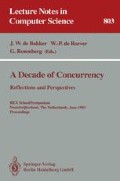Abstract
Models for concurrency can be classified with respect to the three relevant parameters: behaviour/system, interleaving/noninterleaving, linear/branching time. When modelling a process, a choice concerning such parameters corresponds to choosing the level of abstraction of the resulting semantics. The classifications are formalized through the medium of category theory.
Basic Research In Computer Science, Centre of the Danish Natural Science Foundation.
Preview
Unable to display preview. Download preview PDF.
References
M. A. Bednarczyk. Categories of Asynchronous Transition Systems. PhD Thesis, University of Sussex, 1988.
J. Gischer. The Equational Theory of Pomsets. Theoretical Computer Science, n. 61, pp. 199–224, 1988.
J. Grabowski. On Partial Languages. Fundamenta Informaticae, n. 4, pp. 428–498, 1981.
M. Hennessy. Algebraic Theory of Processes. Cambridge, Massachusetts, 1988.
C.A.R. Hoare. Communicating Sequential Processes. Englewood Cliffs, 1985.
P.W. Hoogers, H.C.M. Kleijn, and P.S. Thiagarajan. A Trace Semantics for Petri Nets. In Proceedings of ICALP '92, LNCS, n. 623, pp. 595–604, Springer Verlag, 1992.
R.M. Keller. Formal Verification of Parallel Programs. Communications of the ACM, n. 19, vol. 7, pp. 371–384, 1976.
S. MacLane. Categories for the Working Mathematician. GTM, Springer-Verlag, 1971.
A. Mazurkiewicz. Basic Notions of Trace Theory. In lecture notes for the REX summerschool in temporal logic, LNCS n. 354, pp. 285–363, Springer-Verlag, 1988.
R. Milner. Communication and Concurrency. Englewood Cliffs, 1989.
M. Nielsen, G. Plotkin, and G. Winskel. Petri nets, Event Structures and Domains, part 1. Theoretical Computer Science, n. 13, pp. 85–108, 1981.
C.A. Petri. Kommunikation mit Automaten. PhD thesis, Institut für Instrumentelle Mathematik, Bonn, FRG, 1962.
G. Plotkin. A Structural Approach to Operational Semantics. Technical report DAIMI FN-19, Computer Science Department, Aarhus University, 1981.
V. Pratt. Modeling Concurrency with Partial Orders. International Journal of Parallel Processing, n. 15, pp. 33–71, 1986.
V. Sassone, M. Nielsen, and G. Winskel. A Classification of Models for Concurrency. In Proceedings of Fourth International Conference on Concurrency Theory, CONCUR '93, LNCS n. 715, pp. 82–96, Springer-Verlag, 1993.
V. Sassone, M. Nielsen, and G. Winskel. Deterministic Behavioural Models for Concurrency. In Proceedings of 18th International Symposium on the Mathematical Foundations of Computer Science, MFCS '93, LNCS n. 711, pp. 682–692, Springer-Verlag, 1993.
M.W. Shields. Concurrent Machines. Computer Journal, n. 28, pp. 449–465, 1985.
A. Stark. Concurrent Transition Systems. Theoretical Computer Science, n. 64, pp. 221–269, 1989.
P. Starke. Traces and Semiwords. LNCS, n. 208, pp. 332–349, Springer-Verlag, 1985.
G. Winskel. Event Structure Semantics of CCS and Related Languages. In proceedings of ICALP '82, LNCS n. 140, pp. 561–567, Springer-Verlag, 1982. Expanded version available as technical report DAIMI PB-159, Computer Science Department, Aarhus University.
G. Winskel. Synchronization Trees. Theoretical Computer Science, n. 34, pp. 33–82, 1985.
G. Winskel. Event Structures. In Advances in Petri nets, LNCS n. 255, pp. 325–392, Springer-Verlag, 1987.
G. Winskel, and M. Nielsen. Models for Concurrency. To appear in the Handbook of Logic in Computer Science, eds. S. Abramsky, D. Gabbay, Oxford University Press, to appear.
Author information
Authors and Affiliations
Editor information
Rights and permissions
Copyright information
© 1994 Springer-Verlag Berlin Heidelberg
About this paper
Cite this paper
Nielsen, M., Sassone, V., Winskel, G. (1994). Relationships between models of concurrency. In: de Bakker, J.W., de Roever, W.P., Rozenberg, G. (eds) A Decade of Concurrency Reflections and Perspectives. REX 1993. Lecture Notes in Computer Science, vol 803. Springer, Berlin, Heidelberg. https://doi.org/10.1007/3-540-58043-3_25
Download citation
DOI: https://doi.org/10.1007/3-540-58043-3_25
Published:
Publisher Name: Springer, Berlin, Heidelberg
Print ISBN: 978-3-540-58043-0
Online ISBN: 978-3-540-48423-3
eBook Packages: Springer Book Archive

